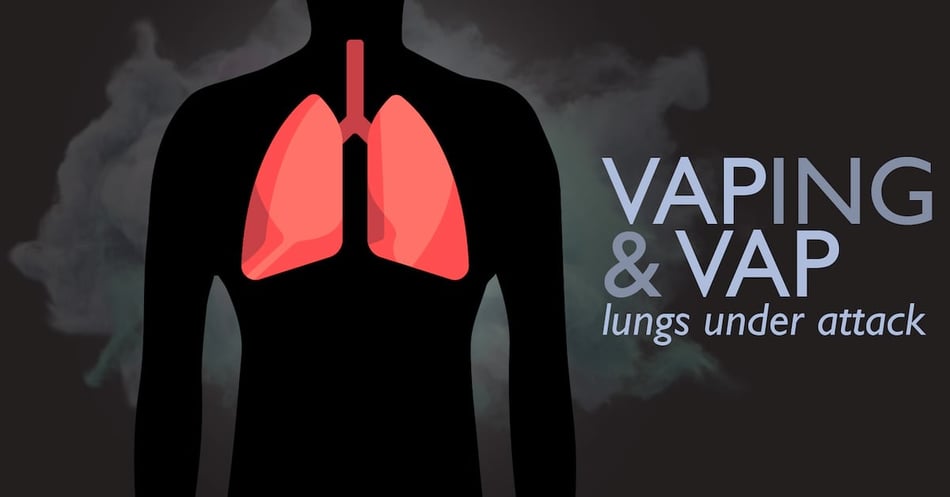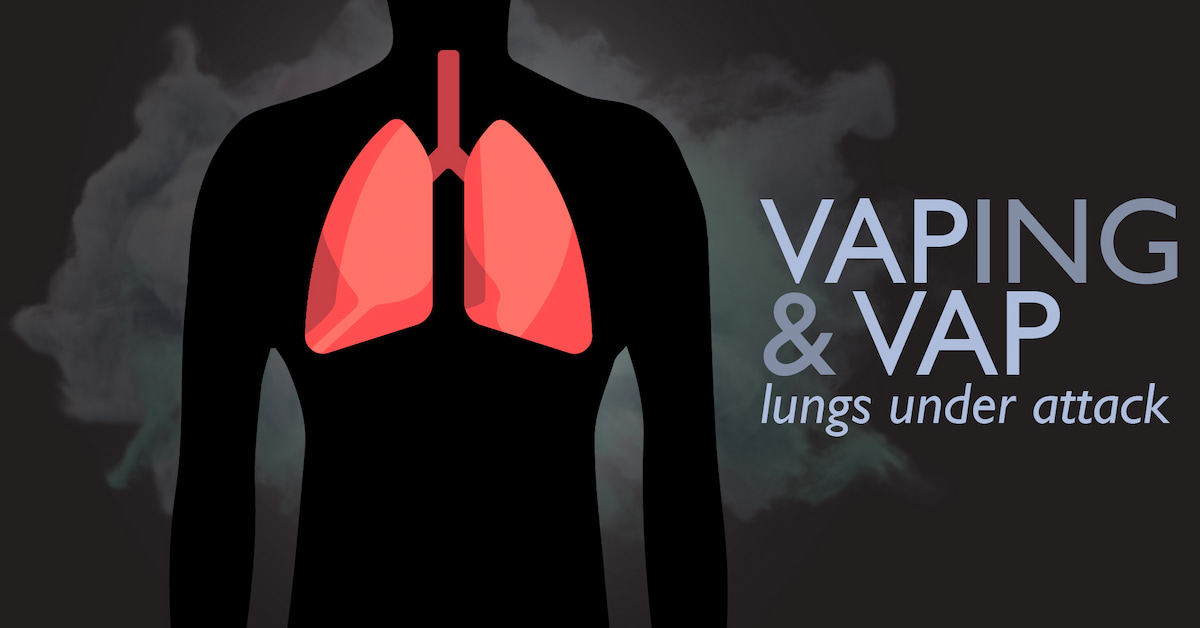VAPING & VAP: Lungs Under Attack

 News stories about the dangerous - and sometimes lethal - effects of vaping have been making headlines. This increasingly popular method of nicotine delivery, electronic cigarettes, has resulted in some perplexing cases of lung disease. In today's post, we'll explore what is known about this vaping-associated pneumonia by comparing it to a common HAI, ventilator-associated pneumonia, or VAP.
News stories about the dangerous - and sometimes lethal - effects of vaping have been making headlines. This increasingly popular method of nicotine delivery, electronic cigarettes, has resulted in some perplexing cases of lung disease. In today's post, we'll explore what is known about this vaping-associated pneumonia by comparing it to a common HAI, ventilator-associated pneumonia, or VAP.
First, let’s talk about the technology behind both conditions. Both e-cigarettes and ventilators use air to deliver a substance to the lungs. In the case of e-cigarettes, a coil is heated enough to vaporize oils and nicotine-containing liquid, which the user then inhales into his or her lungs. The e-cigarette is simple and compact, with many not much larger than a USB flash drive.
Ventilators, on the other hand, are complex computer-modulated machines that use a pump to force air (room air or air enriched with oxygen) into and out of a patient’s lungs through tubes and a facial mask. Typically, patients on a ventilator are unable to breath (at all, or sufficiently) on their own. Healthcare workers adjust the amount of oxygen delivered to the patient, and if the recovery process permits, assist in weaning the patient from the need of a ventilator.
Now let’s take a moment to consider the biology of the lungs and how they interact with these technologies. The lungs expand and contract to bring in outside air and exhale carbon dioxide. The inhaled air travels to the very tips of the branching bronchi to the alveoli, tiny sacs that fill with air and deliver oxygen to the blood. When a user inhales vapor from an e-cigarette, the vapor is taken down into the air sacs where the drug, in most cases nicotine (but most with the condition are inhaling THC, the drug found in marijuana) is delivered to the bloodstream. In the case of ventilators, tubes bring the air directly to the lungs, bypassing the mouth and trachea. However, ventilators also bypass the body’s natural filtration provided by the mucous membranes of the mouth and nose, so ventilator air must be free of contamination of any kind.
And now, the potential risks associated with vaping and ventilators. Essentially, both vaping-associated disease and ventilator-associated pneumonia are caused by the same thing: Substances getting into the lungs that should not be there. With vaping-related pneumonia, the oils used to emulsify the drugs can become droplets big enough to damage the fragile alveoli, resulting in dead cells and hampering the immune system response. With ventilator associated pneumonia, or VAP, bacteria from contaminated tubes or from aspiration by the patient travel directly to the lung tissues, where they are able to colonize with little to no interruption.
How can these conditions be avoided? With vaping, the answer is straightforward: Don't vape. The jury is still out on whether or not vaping is safer than smoking, according to the CDC. Vaping might still be better than inhaling the smoke from cigarettes, but non-tobacco users should not start in the first place. Most importantly, if you do vape, don't modify the delivery system or use bootlegged ingredients. Vaping products are already not heavily regulated, so off-market materials are even less so.
In the case of VAP, the answer is more complex. Sterile processes for inserting the ventilator tube are essential, as are proper placement of the patient and regular monitoring and clearing of the airway. The goal is to prevent contamination from entering or colonizing the fragile lung tissues, so healthcare workers and caregivers must pay close attention to hand hygiene and consistent cleaning of environmental surfaces. While progress is being made in reducing VAP, it remains a significant mortality risk, especially among older patients.
We hope this comparison was helpful in identifying similarities and differences between vaping and VAP lung conditions. We will return to the topic as researchers discover more about the risk factors and etiology of this new health threat.
![EOScu Logo - Dark - Outlined [07182023]-01](https://blog.eoscu.com/hubfs/Eoscu_June2024/Images/EOScu%20Logo%20-%20Dark%20-%20Outlined%20%5B07182023%5D-01.svg)





